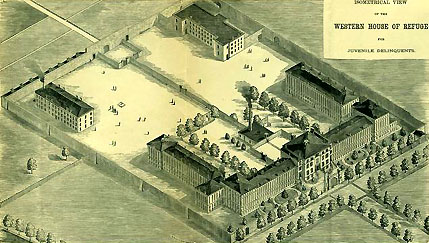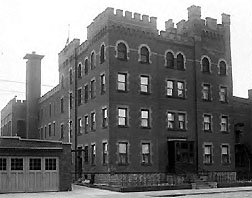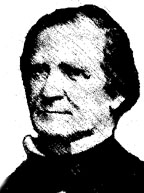Blake F. McKelvey's 1972 A History of Penal and Correctional Institutions in the Rochester Area
[McKelvey pages 9 through 12] Rochester's penal institutions responded in varying ways to the impact of the Civil War. The county jail, considerably relieved by the diversion of children and misdemeanants to other institutions in the fifties, found itself neglected and permitted its standards to deteriorate during the war. In sharp contrast, the county penitentiary under the management of Levi S. Fulton, who after a brief interlude succeeded Brockway, maintained his work program and, with the aid of Samuel Luckey, the chaplain in Brockway's final years, introduced new educational programs.
As the demand of the army increased, the number of men in the penitentiary declined, and in December 1863 it applied to the federal government for and received a detachment of federal prisoners to occupy its cells and and staff its industries. Since Churchill & Company, which now operated its shoe shop, had large orders from the army to fill, the arrangement proved advantageous to all concerned. Some of the increasing number of women committed to the penitentiary worked in the tailor and chair caning shops or at other productive tasks. The management had difficulty in housing upwards of a hundred of them in the 72 cells now available in the women's block, but the end of the war brought a decline in such commitments. The Civil War had a different impact on the House of Refuge. Some of its inmates were the restless sons of men recruited into the army and who sorely missed parental discipline. An increasing number of commitments forced the House of Refuge to rush the completion of a third cell wing. But the opportunity to discharge some of its older boys into the armed services provided a new outlet, which prompted 91 enlistments in 1862 and 24 in the following year despite the sharp drop in the number of older boys.
Rising prices stimulated increased production in the contract shops and gave the institution a thriving quality that permeated all aspects of its regime. The war's aftermath presented graver problems to Rochester's penal institutions than had the great conflict itself. Deprived of the opportunity to release some of their more restless inmates into the armed services, both the Penitentiary and the House of Refuge saw the number of troublemakers increase and experienced new disciplinary problems. Disruptions in their work programs increased as the contractors, deprived of army orders, reduced their schedules or endeavored to introduce new manufacturing techniques.
A destructive fire, apparently of accidental origin, gutted the shops and part of the engine house at the penitentiary in 11865, suspended all production for a time there, and apparently prompted several lads at the House of Refuge to start a fire in its work shop a few months later. That fire was quickly extinguished with the aid of a water system installed in the previous year, and the rebuilding of the penitentiary facilitated the introduction of several improvements including the provision of running water in its cell blocks and shops too. But slack employment coupled with increased commitments at the House of Refuge seriously disrupted its discipline. Several outbreaks of violence prompted an investigation that brought many sorry details to light. Although the investigators cleared Superintendent Wood of the more flagrant charges, they took a grave view of the breakdown in discipline, placing part of the blame on the brutal character of some of the production foremen hired by the contractors. Final responsibility, however, rested with the superintendent who tendered his resignation at the end of the year. Unfortunately the institution's deficiencies were not easily corrected, and his successor, after a succession of frustrating disturbances, also resigned. Finally George J. Whitney, the new president of the board, persuaded Levi S. Fulton, whose management of the penitentiary had proved exemplary, to resign that post in 1870 and assume charge at the House of Refuge. To restore order at the House of Refuge Superintendent Fulton terminated a contract which had mixed a number of outside workmen with the inmates to boost production but with deleterious effects on the boys involved. He also introduced a program of military drills and a system of merit badges patterned after a scheme devised at the Chicago House of Correction and described at the first National Prison Convention which he had attended at Cincinnati the year before. He endorsed a recommendation by Enoch Cobb Wines of the New York Prison Association that all contract labor be abolished in juvenile institutions, and in testimony before a New York State Commission on Prison Labor, he advocated that all productive activity should be entrusted to the management of the superintendent and his staff. But since most state officials feared a breakdown in discipline if any interruption in the work schedule occurred, action on the proposal was deferred. |


 ii
ii

